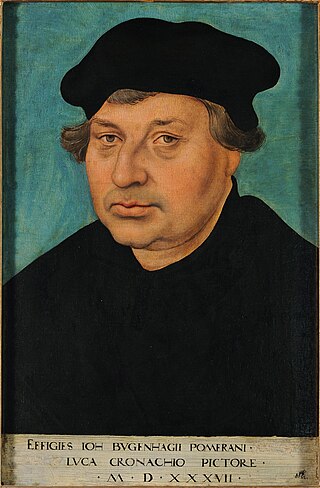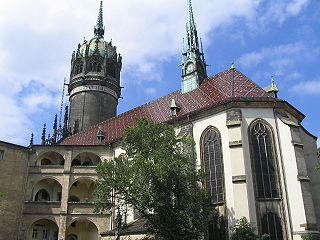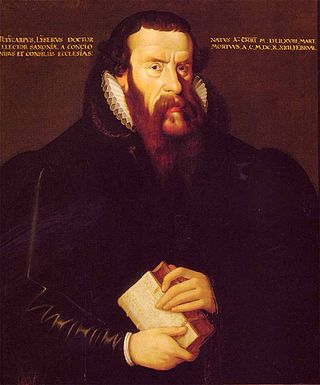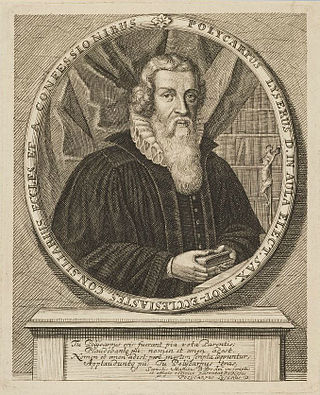
Wittenberg, is the fourth-largest town in Saxony-Anhalt, Germany. Wittenberg is situated on the River Elbe, 60 kilometers (37 mi) north of Leipzig and 90 kilometers (56 mi) south-west of Berlin, and has a population of 46,008 (2018).

Lucas Cranach the Younger was a German Renaissance painter and portraitist, the son of Lucas Cranach the Elder and brother of Hans Cranach.

Lucas Cranach the Elder was a German Renaissance painter and printmaker in woodcut and engraving. He was court painter to the Electors of Saxony for most of his career, and is known for his portraits, both of German princes and those of the leaders of the Protestant Reformation, whose cause he embraced with enthusiasm. He was a close friend of Martin Luther. Cranach also painted religious subjects, first in the Catholic tradition, and later trying to find new ways of conveying Lutheran religious concerns in art. He continued throughout his career to paint nude subjects drawn from mythology and religion.
A Judensau is a folk art image of Jews in obscene contact with a large sow, which in Judaism is an unclean animal, that appeared during the 13th century in Germany and some other European countries; its popularity lasted for over 600 years.

Johannes Bugenhagen, also called Doctor Pomeranus by Martin Luther, was a German theologian and Lutheran priest who introduced the Protestant Reformation in the Duchy of Pomerania and Denmark in the 16th century. Among his major accomplishments was organization of Lutheran churches in Northern Germany and Scandinavia. He has also been called the "Second Apostle of the North".

Vom Schem Hamphoras, full title: Vom Schem Hamphoras und vom Geschlecht Christi, was a book written by German Reformation leader Martin Luther in 1543, in which he equated Jews with the Devil and described them in vile language.

All Saints' Church, commonly referred to as Schlosskirche to distinguish it from the Stadtkirche of St. Mary's, sometimes known as the Reformation Memorial Church, is a Lutheran church in Wittenberg, Saxony-Anhalt, Germany. It is the site where, according to Philip Melanchthon, the Ninety-five Theses were posted by Martin Luther in 1517, launching the beginning of the Protestant Reformation.

The Last Supper of Jesus and the Twelve Apostles has been a popular subject in Christian art, often as part of a cycle showing the Life of Christ. Depictions of the Last Supper in Christian art date back to early Christianity and can be seen in the Catacombs of Rome.

After Luther's objections to large public religious images had started to fade, Lucas Cranach the Elder, along with his son and workshop began to work on a number of altarpieces of the Last Supper, among other subjects.

Polykarp (von) Leyser the Elder or Polykarp Leyser I was a Lutheran theologian, superintendent of Braunschweig, superintendent-general of the Saxon church-circle, professor of theology at the University of Wittenberg and chief court-preacher and consistorial-councillor of Saxony.

Polykarp Leyser II was a German Lutheran theologian and superintendent in Leipzig. He was professor of theology since 1613.

The Lutherhaus is a writer's house museum in Lutherstadt Wittenberg, Germany. Originally built in 1504 as part of the University of Wittenberg, the building was the home of Martin Luther for most of his adult life and a significant location in the history of the Protestant Reformation. Luther was living here when he wrote his 95 Theses.

Elisabeth Cruciger, a German writer, was the first female poet and hymnwriter of the Protestant Reformation and a friend of Martin Luther.

The church of St Peter and Paul in Weimar, Germany, is also known as Herderkirche after Johann Gottfried Herder. It is the most important church building of the town, and is called Stadtkirche, opposed to the courtly Schloßkirche. It has been the church of a Lutheran parish since 1525, after the Reformation. The church is part of the World Heritage Site Classical Weimar, together with other sites affiliated with the Weimar Classicism movement. Inscribed on the World Heritage List in 1998, these sites bear testimony to the cultural importance of Weimar during the late 18th and 19th centuries and the outstanding architecture that arose in response to the cultural values of the time.

Lukas Furtenagel (1505–1546) was a German painter.

Lutheran art consists of all religious art produced for Lutherans and the Lutheran churches. This includes sculpture, painting, and architecture. Artwork in the Lutheran churches arose as a distinct marker of the faith during the Reformation era and attempted to illustrate, supplement and portray in tangible form the teachings of Lutheran theology.

Gregor Brück (1485–1557) was a 16th-century figure of the Reformation, and Saxon Chancellor. He is also known by his latinised name Gregorius Pontanus. His role in the early 16th century in Germany, as legal advisor to Martin Luther, may be said to earn him the title of Lawyer of the Reformation. Although now much forgotten or unknown, his contribution to European history was almost certainly world-changing.

Law and Grace is considered one of the most important paintings by Lucas Cranach the Elder. This work, in the collection of the National Gallery in Prague, is one of the two oldest known versions of this theme, and was executed in 1529. It is also called the Prague type and provided the model for a series of other paintings including an early 16th-century copy that is also kept in the Prague National Gallery's collection of Old European art. It is the best-known and most influential allegory depicting the fundamental tenets of Luther's reform of the church.

Weimar Cranach Altarpiece is a Lutheran winged altarpiece created by Lucas Cranach the Elder and his son Lucas Cranach the Younger between 1552 and 1555 for the Church of St. Peter und Paul in Weimar, Germany.

Wittenberg Cranach Altarpiece is one of the major Lutheran winged altarpieces created by Lucas Cranach the Elder and his son Lucas Cranach the Younger for the Evangelical Lutheran City and Parish Church of St. Mary's in Wittenberg, Germany. The altarpiece depicts the key figures of the Lutheranism associated with the parish church of Wittenberg.































